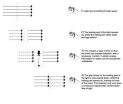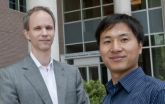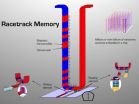(Press-News.org) The study, by researchers from Imperial College London, involves a new class of materials called metamaterials, which can be artificially engineered to distort light or sound waves. With conventional materials, light typically travels along a straight line, but with metamaterials, scientists can exploit a wealth of additional flexibility to create undetectable blind spots. By deflecting certain parts of the electromagnetic spectrum, an image can be altered or made to look like it has disappeared.
Previously, a team led by Professor Sir John Pendry at Imperial College London showed that metamaterials could be used to make an optical invisibility cloak. Now, a team led by Professor Martin McCall has mathematically extended the idea of a cloak that conceals objects to one that conceals events.
"Light normally slows down as it enters a material, but it is theoretically possible to manipulate the light rays so that some parts speed up and others slow down," says McCall, from the Department of Physics at Imperial College London. When light is 'opened up' in this way, rather than being curved in space, the leading half of the light speeds up and arrives before an event, whilst the trailing half is made to lag behind and arrives too late. The result is that for a brief period the event is not illuminated, and escapes detection. Once the concealed passage has been used, the cloak can then be 'closed' seamlessly.
Such a space-time cloak would open up a temporary corridor through which energy, information and matter could be manipulated or transported undetected. "If you had someone moving along the corridor, it would appear to a distant observer as if they had relocated instantaneously, creating the illusion of a Star-Trek transporter," says McCall. "So, theoretically, this person might be able to do something and you wouldn't notice!"
While using the spacetime cloak to make people move undetected is still science fiction, there are many serious applications for the new research, which was funded by the Engineering and Physical Sciences Research Council (EPSRC) and the Leverhulme Trust. Co-author Dr Paul Kinsler developed a proof of concept design using customised optical fibres, which would enable researchers to use the event cloak in signal processing and computing. A given data channel could for example be interrupted to perform a priority calculation on a parallel channel during the cloak operation. Afterwards, it would appear to external parts of the circuit as though the original channel had processed information continuously, so as to achieve 'interrupt-without-interrupt'.
Alberto Favaro, who also worked on the project, explains: "Imagine computer data moving down a channel to be like a highway full of cars. You want to have a pedestrian crossing without interrupting the traffic, so you slow down the cars that haven't reached the crossing, while the cars that are at or beyond the crossing get sped up, which creates a gap in the middle for the pedestrian to cross. Meanwhile an observer down the road would only see a steady stream of traffic." One issue that cropped up during their calculations was to speed up the transmitted data without violating the laws of relativity. Favaro solved this by devising a clever material whose properties varied in both space and time, allowing the cloak to be formed.
"We're sure that there are many other possibilities opened up by our introduction of the concept of the spacetime cloak,' says McCall, "but as it's still theoretical at this stage we still need to work out the concrete details for our proposed applications."
Metamaterials is an expanding field of science, with a vast array of potential uses, spanning defence, security, medicine, data transfer and computing. Many ordinary household devices that work using electromagnetic fields could be made more cheaply or to work at higher speeds. Metamaterials could also be used to control other types of waves as well as light, such as sound or water waves, opening up potential applications for protecting coastal or offshore installations, or even engineering buildings to withstand earthquake waves.
INFORMATION:
For further information please contact:
Katherine Barnes
Interim Research Media Officer (Natural Sciences)
Imperial College London
Email: c.temp2@imperial.ac.uk
Tel: +44 (0) 20 7594 6702
Out of hours duty press officer: +44(0)7803 886 248
Notes to editors:
1."A spacetime cloak, or a history editor" Journal of Optics 16 November 2010
Link to paper: https://fileexchange.imperial.ac.uk/files/d9fd4f2069d/McCall_jopt_final.pdf
Research carried out at Imperial College London and University of Salford.
Corresponding author: Martin W McCall, Imperial College London.
For full list of authors please see paper.
2. Link to basic animation of the paper and caption/credit information:
https://fileexchange.imperial.ac.uk/files/cde5bae3f69/stcloak.gif
https://fileexchange.imperial.ac.uk/files/52d49b779d6/Spacetime%20cloak_Kinsler%20animation.docx
3. The Engineering and Physical Sciences Research Council (EPSRC) is the UK's main agency for funding research in engineering and physical sciences. EPSRC invests around £850 million a year in research and postgraduate training, to help the nation handle the next generation of technological change. The areas covered range from information technology to structural engineering, and mathematics to materials science. This research forms the basis for future economic development in the UK and improvements for everyone's health, lifestyle and culture. EPSRC also actively promotes public awareness of science and engineering. EPSRC works alongside other Research Councils with responsibility for other areas of research. The Research Councils work collectively on issues of common concern via research Councils UK. Website: http://www.epsrc.ac.uk
4. The Leverhulme Trust was established in 1925 under the Will of the First Viscount Leverhulme with the instruction that its resources should be used to support "scholarships for the purposes of research and education." Since that time, the Trust has provided funding for research projects, fellowships, studentships, bursaries and prizes; it operates across all the academic disciplines, the ambition being to support talented individuals as they realise their personal vision in research and professional training. With annual funding of some £50 million, the Trust is amongst the largest all-subject providers of research funding in the UK. The Trust places special weight on: the originality of the projects put to them; the significance of the proposed work; the ability to judge and take appropriate risk in the project; the removal of barriers between traditional disciplines. Website: http://www.leverhulme.ac.uk/
5. About Imperial College London: Consistently rated amongst the world's best universities, Imperial College London is a science-based institution with a reputation for excellence in teaching and research that attracts 14,000 students and 6,000 staff of the highest international quality. Innovative research at the College explores the interface between science, medicine, engineering and business, delivering practical solutions that improve quality of life and the environment - underpinned by a dynamic enterprise culture. Since its foundation in 1907, Imperial's contributions to society have included the discovery of penicillin, the development of holography and the foundations of fibre optics. This commitment to the application of research for the benefit of all continues today, with current focuses including interdisciplinary collaborations to improve global health, tackle climate change, develop sustainable sources of energy and address security challenges. In 2007, Imperial College London and Imperial College Healthcare NHS Trust formed the UK's first Academic Health Science Centre. This unique partnership aims to improve the quality of life of patients and populations by taking new discoveries and translating them into new therapies as quickly as possible. Website: www.imperial.ac.uk
'Space-time cloak' to conceal events revealed in new study
Cloak allows objects to move undetected, according to a paper in the Journal of Optics
2010-11-16
ELSE PRESS RELEASES FROM THIS DATE:
Heavy smoking during pregnancy linked to kids becoming repeat offenders as adults
2010-11-16
Mums who smoke heavily while pregnant run the risk of having kids who grow up to become repeat criminal offenders, suggests research published online in the Journal of Epidemiology and Community Health.
The findings held true, even after taking account of a comprehensive range of family and social factors, such as mental ill health and deprivation, which are likely to influence behaviours, the research showed.
The authors base their findings on just under 4000 adults aged between 33 and 40, who were part of the Rhode Island cohort of the Collaborative Perinatal Project. ...
Passive smokers at increased risk of hearing loss
2010-11-16
Non-smokers who regularly breathe in others' tobacco smoke are at increased risk of some degree of hearing loss, reveals research published online in Tobacco Control.
Previous research indicates that former and current smokers are more likely to lose some of their full range of hearing, but it's not been known whether passive smokers are also prone to this.
The authors drew on 1999-2004 data from the National Health and Nutrition Examination Survey (NHANES), a yearly household survey combined with a physical examination of a representative sample of the US population. ...
US scientists significantly more likely to publish fake research
2010-11-16
US scientists are significantly more likely to publish fake research than scientists from elsewhere, finds a trawl of officially withdrawn (retracted) studies, published online in the Journal of Medical Ethics.
Fraudsters are also more likely to be "repeat offenders," the study shows.
The study author searched the PubMed database for every scientific research paper that had been withdrawn—and therefore officially expunged from the public record—between 2000 and 2010.
A total of 788 papers had been retracted during this period. Around three quarters of these papers ...
The color of medicine
2010-11-16
According to recent research the color, shape, taste and even name of a tablet or pill can have an effect on how patients feel about their medication. Choose an appropriate combination and the placebo effect gives the pill a boost, improves outcomes and might even reduce side effects. Now, researchers at the University of Bombay, New Mumbai, India, have surveyed users of over-the-counter (OTC) medication to find out just how much the color of a tablet influences patient choice.
Writing in the International Journal of Biotechnology, R.K. Srivastava and colleagues report ...
Brain size and a trip to Disneyland
2010-11-16
Evidence from Disneyland suggests that human creativity may have evolved not in response to sexual selection as some scientists believe but as a way to help parents bond with their children and to pass on traditions and cultural knowledge, a new study published in the inaugural issue of the International Journal of Tourism Anthropology suggests.
Evolutionary psychologist Geoffrey Miller of the University of New Mexico has suggested that human creativity, storytelling, humor, wit, music, fantasy, and morality, all evolved as forms of courtship behavior. He used evidence ...
New way of predicting dominant seasonal flu strain
2010-11-16
HOUSTON -- (Nov. 15, 2010) -- Rice University scientists have found a way to predict rapidly whether a new strain of the influenza virus should be included in the annual seasonal flu vaccine. While it sometimes takes new flu strains up to three years to become dominant worldwide, the new method can predict whether they will become dominant as little as two weeks after the sequence first appears in the GenBank database, the National Institutes of Health's collection of all publicly available DNA sequences.
"We studied a new strain of the virus that evolved in British Columbia ...
Child/teen sexual and physical abuse linked to fibroids in premenopausal women
2010-11-16
(Boston) - Researchers from Boston University School of Medicine (BUSM) have found that both physical and sexual abuse history were positively associated with a higher incidence of uterine fibroids later in life. These findings currently appear on-line in the journal Epidemiology.
Uterine leiomyomas, also known as fibroids or myomas, are benign, hormone-dependent tumors that are clinically symptomatic in 20 percent of reproductive age women. Fibroids contribute to a third of hysterectomies in the US, increase risk of infertility, spontaneous abortion and pelvic ...
Racetrack memory
2010-11-16
Annoyed by how long it took his computer to boot up, Kläui began to think about an alternative. Hard disks are cheap and can store enormous quantities of data, but they are slow; every time a computer boots up, 2-3 minutes are lost while information is transferred from the hard disk into RAM (random access memory). The global cost in terms of lost productivity and energy consumption runs into the hundreds of millions of dollars a day.
Like the tried and true VHS videocassette, the proposed solution involves data recorded on magnetic tape. But the similarity ends there; ...
When video games get problematic so do smoking, drug use and aggression
2010-11-16
A new study on gaming and health in adolescents, conducted by researchers at Yale School of Medicine, found some significant gender differences linked to gaming as well as important health risks associated with problematic gaming. Published today in the journal Pediatrics, the study is among the first and largest to examine possible health links to gaming and problematic gaming in a community sample of adolescents.
Rani Desai, associate professor of psychiatry and epidemiology and public health at Yale, and colleagues anonymously surveyed 4,028 adolescents about their ...
New treatment for lung cancer shows promise
2010-11-16
Arlington, Va. — A new inhalable dry powder treatment for lung cancer shows a significant increase in survival rates and is far less invasive than current treatment options, which frequently include radiation and surgery. This research is being presented at the 2010 International Pharmaceutical Federation (FIP) Pharmaceutical Sciences World Congress (PSWC) in association with the American Association of Pharmaceutical Scientists (AAPS) Annual Meeting and Exposition in New Orleans, La., Nov. 14-18.
Lung cancer is the second most common type of cancer in the U.S., accounting ...
LAST 30 PRESS RELEASES:
Ticking time bomb: Some farmers report as many as 70 tick encounters over a 6-month period
Turning garden and crop waste into plastics
Scientists discover ‘platypus galaxies’ in the early universe
Seeing thyroid cancer in a new light: when AI meets label-free imaging in the operating room
Neutrophil-to-lymphocyte ratio may aid risk stratification in depressive disorder
2026 Seismological Society of America Annual Meeting
AI-powered ECG analysis offers promising path for early detection of chronic obstructive pulmonary disease, says Mount Sinai researchers
GIMM uncovers flaws in lab-grown heart cells and paves the way for improved treatments
Cracking the evolutionary code of sleep
Medications could help the aging brain cope with surgery, memory impairment
Back pain linked to worse sleep years later in men over 65, according to study
CDC urges ‘shared decision-making’ on some childhood vaccines; many unclear about what that means
New research finds that an ‘equal treatment’ approach to economic opportunity advertising can backfire
Researchers create shape-shifting, self-navigating microparticles
Science army mobilizes to map US soil microbiome
Researchers develop new tools to turn grain crops into biosensors
Do supervised consumption sites bring increased crime? Study suggests that’s a myth
New mass spec innovation could transform research
Maternal nativity, race, and ethnicity and infant mortality in the US
Migration-related trauma among asylum seekers exposed to the migrant protection protocols
Jupiter’s moon Europa has a seafloor that may be quiet and lifeless
SwRI upgrades nuclear magnetic resonance laboratory for pharmaceutical R&D
House sparrows in northern Norway can help us save other endangered animals
Crohn's & Colitis Foundation survey reveals more than 1/3 of young adults with IBD face step therapy insurance barriers
Tethered UAV autonomous knotting on environmental structures for transport
Decentralized social media platforms unlock authentic consumer feedback
American Pediatric Society announces Vanderbilt University School of Medicine as host institution for APS Howland Visiting Professor Program
Scientists discover first method to safely back up quantum information
A role for orange pigments in birds and human redheads
Pathways to net-zero greenhouse gas emissions for Southeast Asia
[Press-News.org] 'Space-time cloak' to conceal events revealed in new studyCloak allows objects to move undetected, according to a paper in the Journal of Optics


